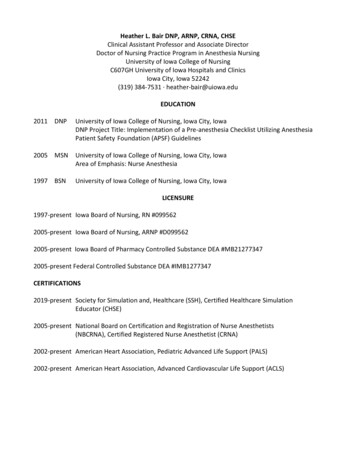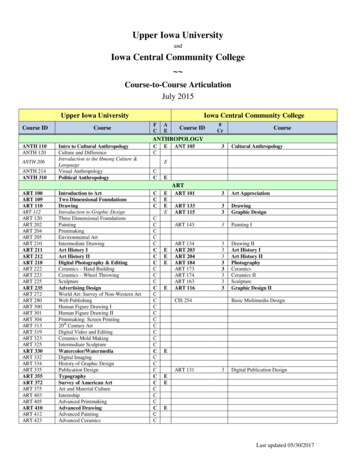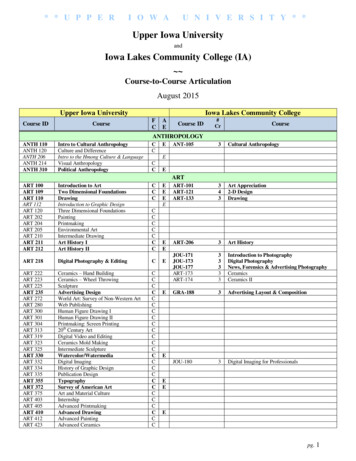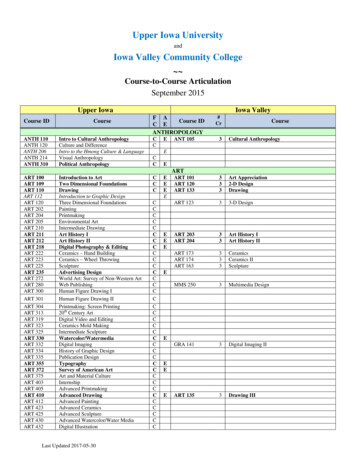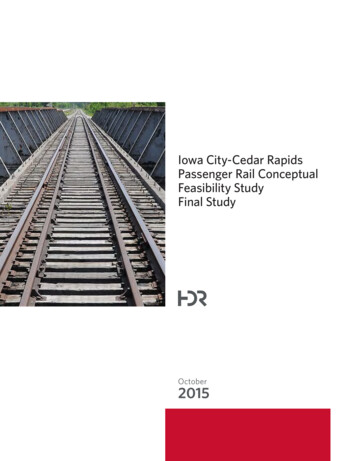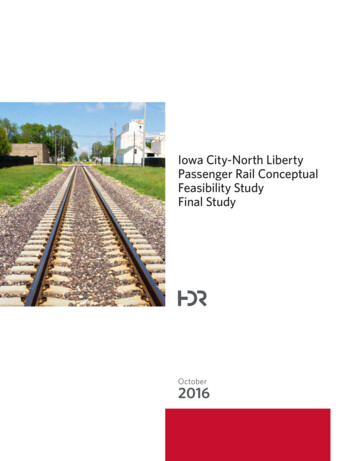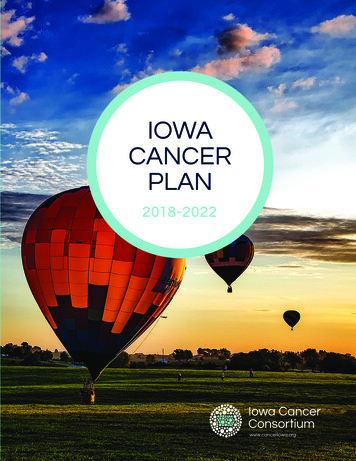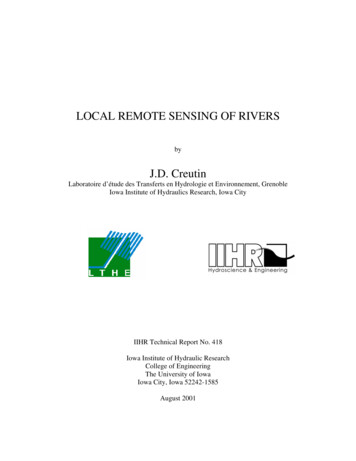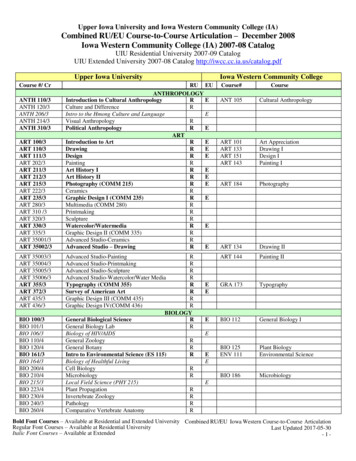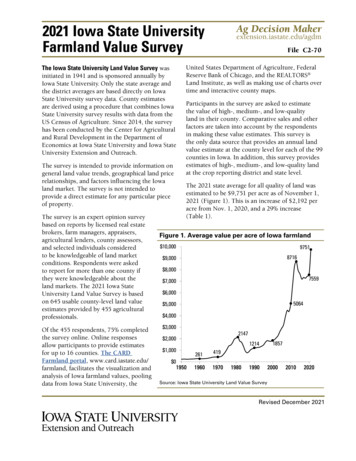
Transcription
Iowa Community-BasedScreening ServicesProcedures Manual2020
Table of Contents1. General Information . 1The Manual . 1Contact Information . 1Importance of Detecting CT/GC . 2Chlamydia and Gonorrhea Testing at SHL . 2Test Performance Characteristics . 3Enrollment in CBSS . 4Quality Assurance. 4CBSS Screening for CT/GC. 7Current Screening Criteria . 102. Data Collection, Specimen Collection, Packaging and Transport . 12Explanation of Data Collection . 12Explanation of Data Fields . 12Medicaid Information . 14Sample of Test Request Form . 18Specimen Collection . 19Packaging and Shipment . 21Criteria for Rejection/QA Events . 22Ordering Specimen Collection Supplies. 223. Test Results and Treatment Information . 24Receiving Test Results from SHL. 24Contacting the Patient with Positive Results . 24Management of Partners and Follow-up . 25Treatment of Chlamydia . 26Treatment of Gonorrhea . 27Presumptive Treatment . 28EPT . 29State Reporting Requirements . 304. Post-Test and Certification . 32Certification Form . 33CBSS Manual Post-Test. 345. Appendices . 36Appendix A – Gen Probe APTIMA Package InsertAppendix B – Web Access Registration FormsAppendix C – Taking a Sexual HistoryAppendix D – Additional Resources0
Iowa Community-Based Screening Services 2020Procedures Manual1. General Information - About Iowa Community-Based ScreeningServices (CBSS)Iowa Community-Based Screening Services (CBSS) is a collaborative project betweenthe Family Planning Council of Iowa (FPCI), the Iowa Department of Public Health’s(IDPH) Family Planning and STD Programs, and the State Hygienic Laboratory at theUniversity of Iowa (SHL). Supported by resources from the state and from the Centers forDisease Control and Prevention (CDC), testing and treatment for chlamydia and gonorrheais done in clinic sites across the state. Data collection is an important part of the CBSS and isused on a state and local basis to examine STD occurrence and trends, guide prevention(including programmatic priorities), and secure funding.The ManualThe purpose of this manual is to provide clinic staff at the CBSS provider sites with aself-study guide to familiarize themselves with the purpose and procedures of the program.Upon receipt, this guide should be read and reviewed by all clinic staff involved with theCBSS. All new employees involved with the program should review the manual within onemonth of hire.After reviewing the manual, the clinicians and other staff should then take the post-testlocated on page 32. This test and registration form should be returned to the CBSSCoordinator and will serve as proof of certification within the CBSS.Contact Information:Colleen BornmuellerIowa CBSS CoordinatorFamily Planning Council of Iowa108 Third Street, Suite 220Des Moines, IA 50309515-288-9028cbornmueller@fpcouncil.com1
Iowa Community-Based Screening Services 2020Procedures ManualImportance of Detecting Chlamydia trachomatis and Neisseria gonorrhoeae*Chlamydia and gonorrhea represent the first and second most commonly reportableconditions in the United States, respectively. The wider availability of affordable, costeffective laboratory diagnostic tests to detect the presence of Chlamydia trachomatis andNeisseria gonorrhoeae has allowed further exploration of the broad spectrum of diseasecaused by these organisms. Reported cases of STDs are at an all time high.In 2018, there were 1,758,668 cases of chlamydia, a 19% increase since 2014, and583,405 cases of gonorrhea, a 63% increase since 2014, reported to the CDC. * 70% of chlamydial infections in women are asymptomatic, as are 50% of gonococcalinfections.Chlamydia and gonorrhea rates are highest in adolescents and young adultsbetween the ages of 15 – 24.CDC estimates that undiagnosed and untreated STDs cause at least 24,000 womento become infertile per year.Untreated chlamydia and gonorrhea lead to epididymitis in some men.Ectopic pregnancy is the leading cause of the first–trimester deaths in the U. S.C. trachomatis can cause neonatal pneumonia. Both C. trachomatis and N.gonorrhoeae can cause neonatal conjunctivitis.C. trachomatis and N. gonorrhoeae increases a woman’s risk of acquiring HIV, ifexposed to the virus.Untreated gonorrhea may lead to disseminated gonococcal infection, a disease inwhich N. gonorrhoeae spreads throughout the body.The Gonococcal Isolate Surveillance Report (GISP) shows decreasing susceptibilityof the cephalosporins to N. gonorrhoeae.*2018 STD Surveillance, Center for Disease Control and Prevention; October 2019Chlamydia and Gonorrhea testing at SHLNucleic acid amplified tests (NAATs) are recommended for the detection ofreproductive tract infections caused by C. trachomatis and N. gonorrhoeae in men andwomen, with or without symptoms. According to CDC, optimal specimen types forNAATs are first catch urine from men and vaginal swabs from women. These collectionmethods should be used by CBSS providers.2
Iowa Community-Based Screening Services 2020Procedures ManualAt SHL, chlamydia and gonorrhea testing are performed using the Gen-ProbeAPTIMA Combo 2 Assay, which is a NAAT.The Gen-Probe APTIMA Combo 2 Assay is FDA-approved for the testing of femalevaginal swabs and male/female urine specimens. The APTIMA Combo 2 Multitest Kit isalso approved to collect oropharyngeal and rectal specimens. Oropharyngeal and rectaltesting is recommended, if indicated from the patient’s sexual history.The sensitivity of the Gen-Probe APTIMA Combo 2 Assay is greater than that ofculture or the EIA assays for the detection of chlamydia and gonorrhea.Test Performance CharacteristicsThere is no perfect test. Testing in low-prevalence populations may result in somefalse-positive results. Positive test results in a low-prevalence population should beinterpreted carefully in conjunction with clinical signs and symptoms, patient riskprofile, and other findings with the understanding that a likelihood of a false-positivetest may be higher than a true positive.Definitions:Sensitivity – The probability of a positive test result given the presence ofdisease. How good is the test at detecting infection in those who have the disease?Specificity – The probability of a negative test result given the absence of thedisease. How good is the test at calling uninfected people negative?Predictive Value – The probability of the presence or absence of disease giventhe results of the test. Positive Predictive Value (PPV) is the probability of disease ina patient with a positive result. Negative Predictive Value (NPV) is the probability ofnot having the disease when the test result is negative. How predictive is the resultfor a patient? This is determined by the sensitivity and specificity of the test, and theprevalence rate of disease in the population testing.Prevalence Rate – The number of cases of illness existing at a given time dividedby the population at risk.The package insert for the APTIMA Combo 2 is included in Appendix A. This includes C.trachomatis sensitivity and specificity charts, the N. gonorrhoeae charts, and the Positiveand Negative Predictive Values by prevalence rates and specimen sources.3
Iowa Community-Based Screening Services 2020Procedures ManualEnrollment in CBSSAll providers must be approved for participation in the program. CBSS clinics includefamily planning, STD, and other agencies targeting disproportionately impactedpopulations or high morbidity areas. Requests will be considered based on fundingavailability, population served, and geographic location.Agencies must sign a Memorandum of Agreement (MOA) with the CBSS to participate.The MOA is intended to provide a written understanding for the expectations of IDPH,CBSS, and the participating clinics. It is not a contract, but will be signed by the CBSSAdministrator, IDPH, and the participating agency program director or manager.Quality AssuranceCBSS recommends methods and sets standards for assuring quality and includes thefollowing identified elements:a. Desk monitoring; this is carried out through analysis of generatedreports developed for the purpose of identifying trends and arisingissues;b. Facility-specific assessments; andc. Treatment/partner services.Considering these methods, the following are the components of the Quality AssurancePlan for the CBSS:Rejected/Unsatisfactory Specimens1. Specimens are monitored as they are submitted to SHL and facilities are notifiedimmediately of specimens that cannot be processed. The SHL establishes guidelinesfor specimen rejection based on the assay package insert and/or the regulatorspecifications.2. The SHL will provide monthly and quarterly reports to the CBSS Coordinator thatincludes all specimens that were found to be unsuitable for testing and the clinicswhere they originated. A quarterly analysis of the rejected specimens and thereasons for rejection will be reported to each facility. (A list of rejection criteria canbe found on page 22.) Contact will be made with any facility with a higherpercentage of rejected specimens than the state average for that quarter. Contactwill be in the form of a letter. If no improvement is shown in the next quarter, aphone call will be made by the CBSS Coordinator to determine the causes andcorrective action needed to be taken, such as on-site training.4
Iowa Community-Based Screening Services 2020Procedures ManualOut of Criteria SpecimensData from the test request forms for each clinic will be reviewed by laboratory staff forbirth date, plus the other information that relates to testing criteria such as insurancestatus, signs and clinical impressions, symptoms, and risk history. Specimens from patientsthat do not meet the CBSS screening criteria may be rejected. If data are incomplete, clinicswill be called to obtain missing information as time allows.Data Collection/AccuracyThe CBSS Coordinator audits the test request forms for appropriate and accurate datacollection. The lab form is the only means for data collection and complete data collection isnecessary for effective program operation. Once a month, the CBSS Coordinator receives aspreadsheet from SHL with the data for each specimen submitted. Data are reviewed forincomplete data fields. A field left blank in an excess of five times in one month isconsidered above the state standard and the clinic submitting the specimen/data will becontacted by email to advise them of the problem. Clinics receiving written notification forthree consecutive months will be notified by phone by the CBSS Coordinator to helpresolve the data issues.Quarterly Reports – Data AnalysisData collected from test request forms is compiled to create the CBSS quarterly andyear-end reports. These reports contain the total number of specimens submitted, total andpercent positive for chlamydia and gonorrhea, and other data related to fields reported tothe CBSS. The CBSS Coordinator will provide a yearly data analysis for the CBSS and eachparticipating provider.Facility Assessments – Site VisitsOn an annual basis, the CBSS Coordinator will monitor a minimum of 20% of thecurrent CBSS facilities during an in-person site visit in relation to the four elements fromthe Iowa Quality Assurance Plan. For most agencies, this will mean a routine site visit everythree years. A visit may be done sooner if there is new staff or issues related to one of thequality assurance elements listed. The four elements covered during the visit include:1.2.3.4.Specimen Collection and SubmissionScreening CriteriaData Collection and AccuracyPatient/Partner Treatment and EducationCBSS providers must be available for site visits scheduled in advance during the clinic’sregular business hours. Site visits typically last between 60 to 90 minutes and are informalin nature. The site visit provides an opportunity to ensure the clinic is not encountering anydifficulties and to provide technical assistance when needed.5
Iowa Community-Based Screening Services 2020Procedures ManualDuring site visits, the CBSS Coordinator will complete the Facility Services Assessment(FSA) form. A copy of the form will be provided to the clinic prior to the visit. Clinic-specificCBSS data will be presented and reviewed.In addition to the FSA, the CBSS Coordinator or other IDPH staff may perform a medicalrecord (chart) review. This will be a review of the IDPH STD 340B Medications program, ifthe clinic is participating. Charts to be reviewed for compliance will be requested the dayof the visit.Within seven days from the date of the site visit, the CBSS Coordinator will notify (byletter) the findings of the visit along with any issues needing corrective action or follow-up.A copy of the final FSA and chart review, if applicable, will also be provided.Laboratory Quality AssuranceThe SHL has been inspected and licensed under CLIA by the Health Care FacilitiesAdministration.6
Iowa Community-Based Screening Services 2020Procedures ManualCBSS Screening for Chlamydia and GonorrheaScreening is commonly defined as “testing in asymptomatic populations.” Because ofthe frequent asymptomatic nature of chlamydial/gonococcal infections, screening becomesessential to controlling disease incidence and preventing potential complications.Economically, it is not possible to screen everyone; therefore, individual regions and statesattempt to find the best criteria for their area based on CDC guidelines, published studies,and local prevalence data.Iowa Code 139A.35 allows for minors to be tested and treated for STDs withoutparental/guardian consent. All CBSS clinics are expected to follow the Code. The followingis the Iowa Code language regarding minors:A minor shall have the legal capacity to act and give consent toprovision of medical care or services to the minor for theprevention, diagnosis, or treatment of a sexually transmitted diseaseor infection by a hospital, clinic, or health care provider. Suchmedical care or services shall be provided by or under thesupervision of a physician licensed to practice medicine and surgeryor osteopathic medicine and surgery, a physician assistant, or anadvanced registered nurse practitioner. Consent shall not be subjectto later disaffirmance by reason of such minority. The consent ofanother person, including but not limited to the consent of a spouse,parent, custodian, or guardian shall not be necessary.Screening RecommendationsThe CDC recommends annual chlamydia screening for all sexually active women 24years of age and younger. Screening for women over 24 years of age is recommended forthose at increased risk (new sex partner, more than one sex partner, a sex partner withconcurrent partners or a partner with a sexually transmitted infection). Data suggest thatscreening sexually active adolescent and young adult males for chlamydia is cost-effectiveand that a relatively high percentage of positivity is found in certain clinic settings andpopulations with a high burden of infection, such as men who have sex with men (MSM).Recommendations against routine screening of young men are based upon anassumption of a positivity rate of less than five percent, in which case screening is not costeffective. However, recent studies indicate a much higher positivity rate among youngmales attending family planning clinics, even when controlling for variables such assigns/symptoms and known exposure to chlamydia. A likely contributing factor is themigration of males from traditional STD clinics to family planning clinics due to thereduction of hours and closing of many stand-alone STD clinics. Local data affirm similarcircumstances for Iowa. For these reasons, the CBSS program does recommend routinescreening of sexually active males 24 years of age and younger.7
Iowa Community-Based Screening Services 2020Procedures ManualIn addition, CDC recommends rescreening individuals, regardless of age, with aprevious positive test. According to their guidelines “Repeat infections confer an elevatedrisk for PID and other complications when compared with the initial infection. Therefore,recently infected women are a major priority for a repeat test for C. trachomatis.” Cliniciansshould advise all women and men with CT/GC infection to be rescreened approximatelythree to four months after treatment.CBSS screening criteria apply to all persons, regardless of gender or sexual orientation.The screening criteria generally refer to urogenital specimens. However, supplementalguidelines have been developed for oropharyngeal and rectal specimens based uponexposure and risk history. A thorough sexual health history should be taken with everypatient, at every visit, to determine possible sites of contact and exposure. Tips for taking asexual health history can be found in Appendix C.Insurance StatusCBSS test kits must be prioritized for individuals who cannot obtain chlamydia andgonorrhea testing because it is cost prohibitive (e.g., lack of or inadequate insurancecoverage) or they are seeking confidential services. This is the first criterion, before anyconsideration of risk (e.g. age) is taken into account. Special consideration is made forfacilities that do not bill or collect fees.Regardless of gender, sexual orientation, or specimen type, the determination ofwhether an individual qualifies for screening using CBSS test kits must be determined usingthe criteria of insurance status, age, and risk factors. The included flow chart should beused to help make this determination. The CBSS screening criteria are used for bothchlamydia and gonorrhea testing. The criteria are based on a combination ofrecommendations (e.g., CDC) and local data. They focus on young age as the primary riskindicator. Other risk factors include new or multiple partners in the last 90 days, reportedsymptoms, and observed clinic findings at the time of the exam.8
Specimens not meeting the screening criteria will be rejected. Clinics will be notified and may report additional information to justify testingof the specimen.9
Community-Based Screening Services - Screening CriteriaSpecimen collection for women may be done using a vaginal swab (self-collected or cliniciancollected) or a urine kit. Specimen collection for men should be done with a urine collection kit. Useof a urine collection kit in an outreach location must have prior approval from the CBSSCoordinator.All Clinic TypesAll persons 24 years of age: Screen all sexually active individuals 24 years of age annuallyo Screen all women 24 prior to IUD insertion, as indicatedo Screening may be offered during walk-in visits; such as pregnancy tests, emergencycontraception, or Depo-Provera injections At an exam within 12 months of a negative chlamydia/gonorrhea test, screen ONLY if anindividual has one or more of the following:o New or multiple partners in the last 90 days (or primary sex partner with new ormultiple partners in the last 90 days)o Reported symptoms consistent with chlamydia or gonorrheao Observed clinical signs consistent with chlamydia, gonorrhea, or PIDo Contact to an STDo IUD insertion (women) All persons 25 years of age:Test all individuals 25 years of age and older if they have one or more of the following:o New or multiple partners in the last 90 days (or primary sex partner with new ormultiple partners in the last 90 days)o Reported symptoms consistent with chlamydia or gonorrheao Observed clinical signs consistent with chlamydia, gonorrhea, or PIDo Contact to an STDo IUD insertion (women)Screening may be offered during walk-in visits, such as pregnancy tests, emergencycontraception, or Depo-Provera injections if they meet the additional criteria above.Rescreen All persons, regardless of gender or age that have a positive chlamydia or gonorrhea testshould be rescreened (tested) in 3 to 4 months following treatment. (This is a check for newor re-infection, not a test of cure.)10
Iowa Community-Based Screening Services 2020Procedures ManualTesting Recommendations with Rectal/Oropharyngeal SpecimensA sexual history of the patient must be taken in order to assess risk and determine theappropriateness of testing. Please note: Oropharyngeal and rectal tests are subject to thesame screening criteria established for urogenital specimens. Please see the screeningcriteria and flow chart first, in order to determine whether a patient is eligible for use of aCBSS test kit.Early studies recommended against testing women for chlamydia and gonorrhea at theanorectal site. Data showed that women who tested positive at the anorectal site also testedpositive at urogenital sites, making anorectal testing unnecessary. Newer studies show that asignificant proportion of women will test positive only at the anorectal site, meaning that someinfections will be missed if women with anorectal exposure are only tested at urogenital sites.Therefore, the CBSS program recommends including questions regarding anorectal exposure beincluded in taking a sexual history with women and if found to be at risk, testing for anorectalchlamydia and gonorrhea be conducted.Testing rectal specimens for gonorrhea and chlamydia is recommended when: The patient (regardless of gender) has had receptive anal intercourse with a male withinthe past year, regardless of condom use.Testing oropharyngeal specimens for gonorrhea and chlamydia is recommended when: The patient (regardless of gender) has performed oral intercourse within the past year.11
Iowa Community-Based Screening Services 2020Procedures Manual2. Data Collection, Specimen Collection, Packaging, and TransportProceduresExplanation of Data CollectionData for the CBSS is submitted on the test request form that accompanies the specimento SHL. It is vital that all fields are complete on every form, every time. Test request formsare printed from the SHL website with your individual clinic information. You maydownload the form and fill it in on the computer or print and fill in by hand. This is the linkto find the chlamydia/gonorrhea test request or.xmlExplanation of Data Fields on the Test Request FormOrganization Information (Results are reported to this address) This field will pre-populate when you print the forms from the SHL website. Be sureto check to make sure the address is correct for your clinic.Ordering Health Care Provider Information The provider line can be the person ordering or obtaining the specimen. This doesnot have to be the same person that is associated with the NPI number. This can bethe NPI number for your facility or the clinician/ provider that is responsible forordering the test and follow up of the results. This may be your facility’s MedicalDirector. You must complete the NPI number when you are submittingMedicaid/MCO or State Family Planning Program information for billing. The phonenumber in this section is the clinic or provider phone number.Patient InformationPatient Please ensure that the name on the test request form and the name on the specimencollection tube are an exact match; otherwise, the laboratory will reject thespecimen. If there is no name on the specimen tube, it will be rejected.Medical Record #/Chart ID/Patient ID Number This is the clinic’s identification number for the patient; it may come from thepatient chart or electronic medical record. If your clinic does not use a patient identifier, it can be left blank but there must betwo forms of patient identification on the test request form and specimen tube.12
Iowa Community-Based Screening Services 2020Procedures ManualBirth DateThe date the patient was born. Use the format of two-digit month, two-digit day, andfour-digit year (e.g., 01/02/2010). If the date is not supplied the clinic will be contactedfor this information. Please report the birthdate on the label of the specimen tubewhenever possible.Social Security Number This information is optional. It is not required by the CBSS for data collectionpurposes. The SHL uses this information for making definite patient identification.If your clinic uses this number for identification purposes, you can record it on thetest request form and/or the specimen tube.Address SHL and the state STD Program use the address for further identification of thepatient in the instance of a positive test. The patient’s address may be used todetermine the exact geographic distribution of disease trends.City of Residence This field is used to determine the county of the patient’s residence. Write out thepatient’s home city, state, and Zip code on the lines provided.Phone Number This information is collected by SHL on all test request forms. It is necessary forpatient follow up by the Disease Intervention Specialist (DIS) only in the instance ofa disease investigation resulting from a positive test. The patient should supply aphone number where they can be reached.Gender Indicate male or female by checking “M” for male or “F” for female. Determination ofsex is made by observation or the medical record. You may also mark Unknown.Race/EthnicityThe categories for reporting race and ethnicity for the CBSS conform to the Office ofManagement and Budget (OMB) 1997 Revision to the Standard for the Classification ofFederal Data on Race and Ethnicity. If this information is not already included in thepatient’s medical record, the information should be collected by self-identification bythe patient. The patient may self-identify or self-report more than one of five racescategories. Those marking more than one race will be collapsed into “More than onerace reported” category in the final state and regional data. Both a racial and ethnicgroup must be marked on every form.Race White: Includes persons of European descent, the Middle East, or North Africa13
Iowa Community-Based Screening Services 2020Procedures ManualBlack: Includes persons having origins in any of the black racial groups of AfricaAmerican Indian or Alaskan Native: Includes persons having origins in any of theIndian peoples in North or South America (including Central America), and whomaintains tribal affiliation or community attachment; Alaskan Indian, Eskimo, andAleut are also included.Asian: Indicates persons having origins in any of the original peoples of the FarEast, Southeast Asia, or the Indian subcontinent including, for example, Cambodia,China, India, Japan, Korea, Malaysia, Pakistan, the Philippine Islands, Thailand, andViet Nam.Native Hawaiian or Other Pacific Islander: Includes persons having origins in any ofthe original peoples of Hawaii, Guam, Samoa, or other Pacific Islands.Unknown: If the patient does not know or does not wish to identify race.Ethnicity Hispanic: Indicates persons having origins of Cuba, Mexico, Puerto Rico, South orCentral America, or other Spanish culture or origin, regardless of race. The term,“Spanish origin”, can be used in addition to “Hispanic” or “Latino”. Non-Hispanic: Includes all other persons. Unknown: I
The Gen-Probe APTIMA Combo 2 Assay is FDA-approved for the testing of female vaginal swabs and male/female urine specimens. The APTIMA Combo 2 Multitest Kit is . The package insert for the APTIMA Combo 2 is included in Appendix A. This includes C. trachomatis sensitivity and specificity charts, the N. gonorrhoeae charts, .


